
"You can't get into whitewater heaven til' you've run the Selway over five feet on the Paradise gauge.."
- anon
The Selway River wild and scenic section is one of the most coveted river trips in the continental United States, second only to the Grand Canyon in terms of permit scarcity. Thousands of paddlers apply for just 62 permits each year, and those lucky few who draw a permit are rewarded with 47 miles of high lonesome as they drift through the heart of Idaho's Selway-Bitteroot Wilderness. Only one launch per day is allowed during permit season, so you probably won't see another person until you reach the take out.
Of course, it is sometimes possible to run the Selway without a permit, but this requires an early snowmelt event to clear the snow off the access roads prior to May 15th, a gamble that rarely pays off. You can also float the river in late summer after the permit season is over (after July 31), but you are likely to find more rocks than water if you do.
The Selway is not a pure wilderness experience; there are a few signs of civilization along the way, including a lodge, a ranch or two, and a trail along the length of the river. All of that aside, the river retains a strong sense of isolation that grows as the days roll by, culminating in the final twenty miles where the river twists through a deep canyon lined with lush, ancient stands of cedar and pine teeming with wildlife.
Our group's permit holder was Ryan Windsor, a remarkably lucky fellow who has also run the Grand Canyon on a permit. Ryan is a former Gauley River video-kayaker (video-kayakers shoot video footage for the Gauley Raft companies as they run the class V drops on that river) so we had a broad cross-section of the country's paddlers represented in our group.
On this particular trip we had Scott Boring from West Virginia, Chuck North and Matt Stamm from Steamboat, Colorado. The Oregon contingent consisted of: Ryan, Jonathan Rawson, Margi Lifsey, Lori Hoffman, Gabe Flock and myself. Matt, Scott, and Chuck are also Gauley guides, which made everyone feel better because Scott and Matt had volunteered to row the gear boats.
Our rendezvous point was the Race Creek campground on the Selway, which is the takeout. The plan was to meet at Race Creek on Tuesday afternoon and start the shuttle on Wednesday morning. Gabe and I headed over to Idaho on Monday, paddled the nearby Lochsa on Tuesday morning, and then started the long 20 mile slog up the dirt road along the river to Race Creek. We were the first to arrive at the take-out, and we started packing as the others drifted in throughout the evening.
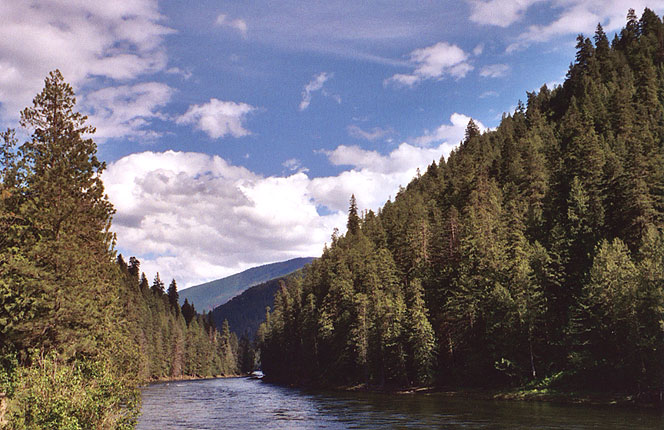
Just below the take-out at Race Creek the river thunders over Selway Falls, an awe-inspiring hydrological horror that we stopped and marveled at for awhile. At this flow, the pile on the bottom hole was over ten feet tall...
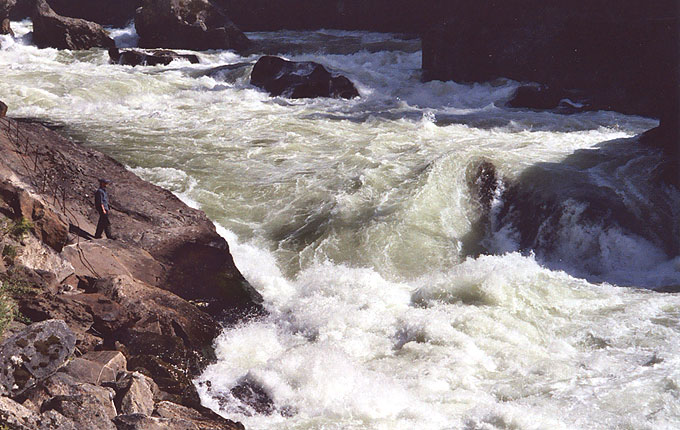
At eight the next morning the bus arrived. Ryan had located a bussing company in Montana (L&B Bussing) which turned out to be an optimal shuttle solution for our group of nine. Our shuttle vehicle was a full-sized school bus with the last five rows of seats removed, so we were able to pile all of our gear into the bus, including a 16 foot gear raft, a 16 foot cataraft and frame, nine people, and all of our kayaks and supplies.
Because we were being picked up at the take out, we were able to leave all of our vehicles there, which was a pretty nice arrangement.
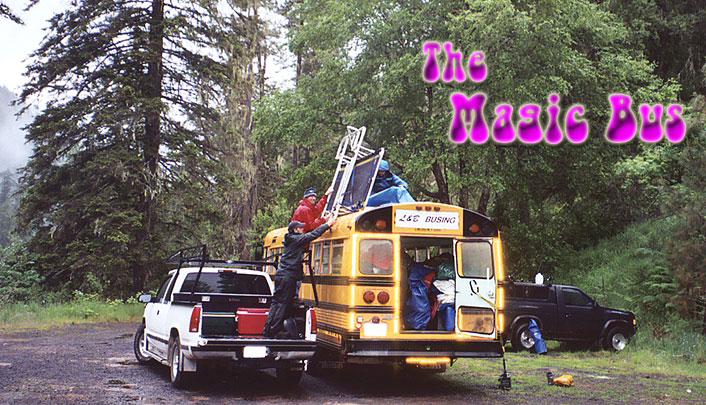
The bus ride to the put-in took all day, but we were entertained the whole way by our driver, John. John told jokes, pointed out sights, and talked for long stretches about living in Montana and how to eat Corndogs Montana-style.. meanwhile, someone broke into the supplies and we drank a significant amount of our beer ration along the way..
Soon enough we dropped down into the Selway drainage and arrived at camp. The rain had moved in so we set up a tarp and set about getting packed. After dinner was finished up we started up a game of 'PBR William Tell', involving a frisbee, a can of PBR duct-taped to a helmet, and lots of laughs. Unfortunately for Matt he kept winning so he had a lot of frisbees bounced off of his head that night.. it was good training for kayaking.. or something.
The rules for Pabst Blue Ribbon (PBR) William Tell:
1. Whoever knocks the beer can off the winner's helmet becomes the winner and gets the frisbee thrown at their head.. er, I mean the beer can.
2. Hitting the winner in the fingers or the face with the frisbee is strictly forbidden unless the winner's name is Matt.
3. The winner.. isn't.
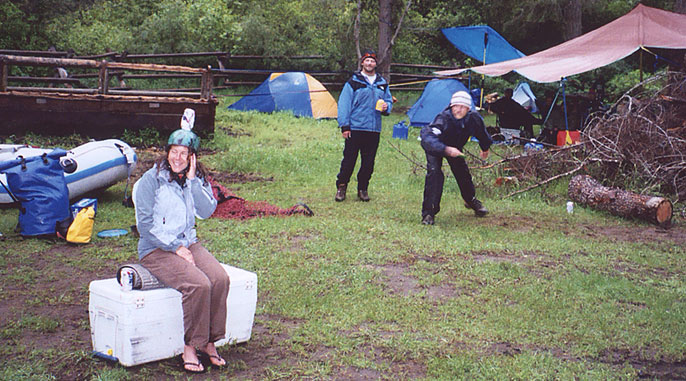
We checked the river in the morning and noted that the gauge had come up rather significantly overnight; it was now reading over 4 feet and showed no signs of slowing it's ascent. We had plenty of water to put on White Cap creek, which flows down into the Selway after about a quarter mile of class II-III. In the past, raft crews had struggled to get past a logjam blocking the near side river-right channel, but this channel was clear of wood when we were there.

Below the put-in the river was narrow and interesting, with lots of corners and no wood to worry about. Soon the river broadened and we had broad, open vistas and more rapids. None of the drops were very tough, but they were very fun and we had some great surfing for the kayakers (All six kayakers were paddling playboats on this trip).
We were all surprised at how much fun the first day was, because the descriptions we had heard didn't mention any rapids on the first day. I suppose that part of this can be attributed to flow, because at this point we were approaching the magical 5 foot mark..
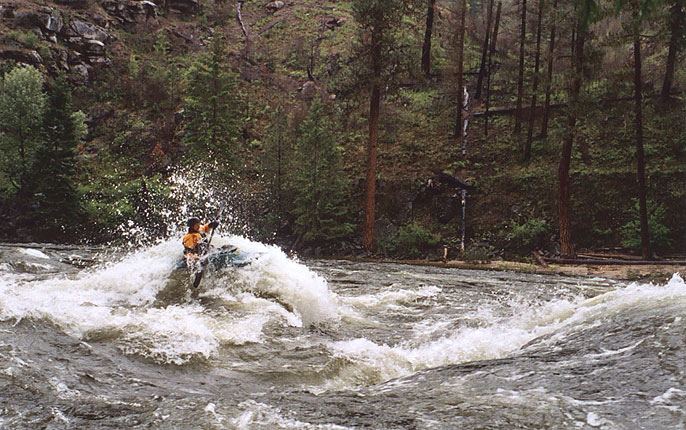
We found a nice campsite on river-left after about ten miles, and set up shop. Upon packing the coolers, we found that the dry ice that had been packed in with the food had done it's job a little too well, because everything on the bottoms of the coolers was frozen solid.
So, on the morning of day three most of the group feasted on 'EggSickles', which is what you get when you pack eggs in dry ice. The EggSickles were reported to be pretty good after a lengthy thawing and preparation process, though I opted for Honey-Nut Cheerios after viewing the uncooked contents of the frying pan, pictured below..
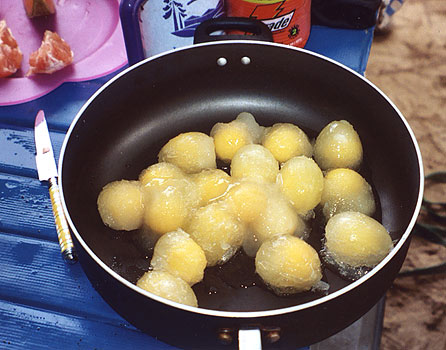
On the morning of day three we noted that the water had come up at least another 6 inches, maybe more. We knew we were heading into the toughest section with flows in the 5-6 foot range, so everyone was pretty excited (and perhaps a little apprehensive, especially for the gear boats).
"Why would someone name a rapid HAM?"
"What does a rapid named HAM look like?"
"Did they have bacon that morning?"
"Did wild boars eat half the group while they were scouting?"
"Is there a hole that eats up boats like a big-ol-pig??"
"HAM! It's a big fat mystery!"
We put in and headed downstream, and as the day wore on the river gradually gained volume as numerous tribs poured in. By the end of the day it became apparent that we were going to have a very difficult time stopping the heavily loaded gearboats, especially once Moose Creek came in and effectively doubled the flow at the end of the day. The sheer volume of the river and speed of the water was becoming a big concern, but we hadn't seen anything yet!
Towards the end of the day the kayakers started ranging ahead, trying to stay far out in front of the gearboats in order to identify scouting eddies far in advance. With this in mind, the Raft and Cataraft stopped and waited for a half hour so the kayakers could get a head start.
Of course, there were so many incredible play waves that after awhile the kayakers were strung out along a mile or so of river. Soon I found myself being left behind because I was spending so much time surfing and generally goofing off, so I sprinted downstream to catch up with the rest of the kayakers. Eventually the kayakers had coalesced into two groups: Ryan, Gabe, and Chuck (out in front) and Lori, Margi, and myself (perhaps the biggest goof-off), in the back.
Soon we arrived at the first class III drop, which was a sweet boulder-garden which we started on the right and finished on the left side. Lori, Margi and myself were able to boat-scout this drop pretty easily, and at this point there was no sign of Ryan, Gabe and Chuck, who were somewhere downstream.
Ham was next, and we really didn't know what to expect. The guides mentioned some kind of class III- drop leading into Ham, but all I remember is a wave train and then all of a sudden we reached a significant horizon line which could only be the Big Pig. I headed down into the rapid and caught a tiny eddy against the right wall to do a little boat-scouting, and when I looked back upstream I was surprised to see Lori and Margi piling into the eddy behind me. After some banging around against the wall we determined that the right side looked ok and Margi peeled out and headed downstream, followed closely by Lori and myself.
Well, to be honest I still don't know why Ham is named Ham, but I do remember accelerating out into the middle of the river at an alarming rate and going over a gigantic wave and getting airborne off the back side of it. This was my first taste of the power of a high-water Selway, and it wouldn't be my last. There were some holes at the bottom of the drop, and I finished out the rapid on the bottom left. There were no boulders or anything to be seen, just big waves and holes everywhere. Ham was super fun, but sadly the mystery of it's name was never solved..
Below Ham we caught up to Gabe, Chuck and Ryan, and we paddled down past the footbridge to the confluence of Moose Creek and stopped to wait for the gearboats. After an hour or so the Matt, Scott, and Jonathan came hiking down the trail (they had managed to stop at the footbridge) so after a brief pow-wow we decided to hike a mile or so downstream and scout the crux canyon section.
Ladle was a mighty impressive sight; the hole in the middle of the river was a thirty-foot wide prison, while the left side wasn't much better. The right side offered a more 'reasonable' line consisting of a series of three ever-larger holes ending with a powerful pourover that would keep a swimmer.
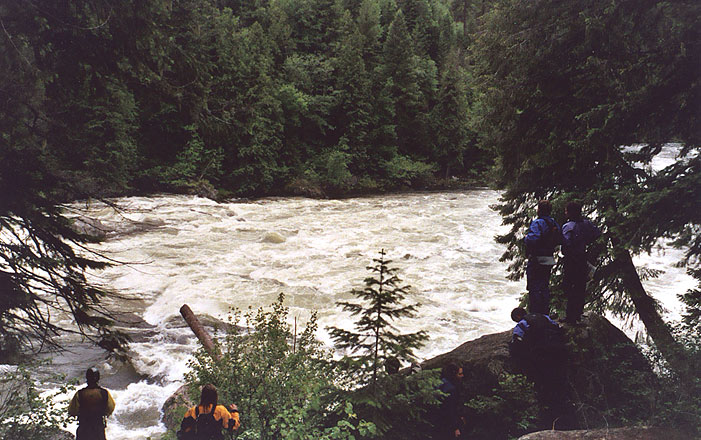
Below Ladle the rapids continued with Little Niagara, Puzzle Creek rapid, Miranda Jane, Osprey, and others. We scouted Little Niagara and Puzzle Creek (Puzzle Creek Rapid is pictured below) but stopped there because the rest of the drops were class III and we weren't too worried about them.
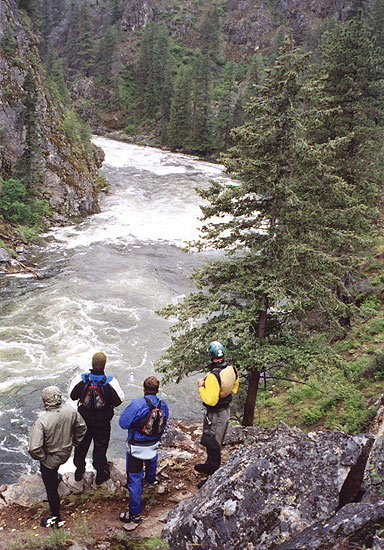
During our scout we had found a nice campground on river-left that was just upstream of Double Drop. The only concern was getting the gear boats into the eddy. With this in mind, the kayakers headed downstream and got set up with ropes while the raft and Cat waited upstream. Soon Matt came bombing down in the cat and managed to make the eddy, but the raft (which we had nicknamed 'Fatty') missed the top eddy and went cruising on by as the throwropes rocketed out from the bank as we vainly tried to slow their descent. Finally, after a huge effort by Scott, he managed to grab the tail-end of an eddy about a hundred yards downstream, and we were able to haul Fatty back upstream to the campsite.
Dinner that night was excellent; Lori and Margi whipped up a huge pot of Spaghetti and Meatballs, and we ate until we couldn't move. By arrangement, the ladies cooked dinner and the guys did the dishes, while breakfast and lunch were fend-for-yourself affairs..
Ryan, Gabe and myself peeled out and headed down into Double Drop, which was just a big wave train at this flow culminating with a huge raft-flipping wave on the bottom right. Gabe and I avoided the biggest wave at the bottom, but Ryan managed to catch and surf it, the biggest wave anyone rode on the trip!! I wish we would have had video footage of his ride, because it was epic!
We got to Ladle and only Gabe decided to run it; Ryan and I didn't feel like dealing with the holes in our playboats, and we knew that if we had a swimmer here in a kayak we would compromise the safety net we were supposed to be providing for the gearboats. Gabe ran Ladle with style down the right side, managing to slip past all of the holes with no problems, and we got ropes set for the gear boats.
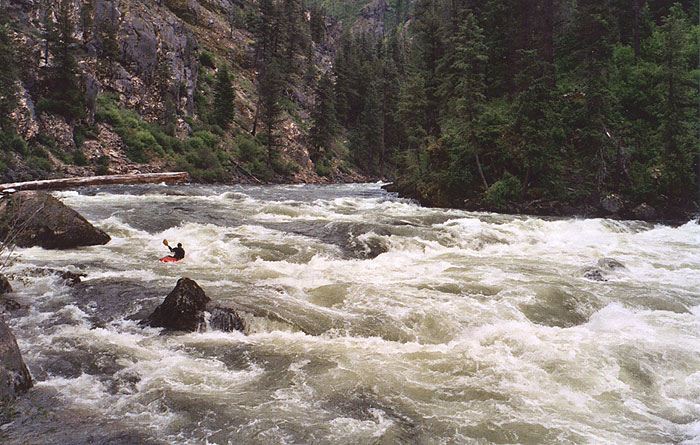
About a half hour later the gearboats launched. Just upstream of Double Drop the gear raft got stopped in a mid-stream wave hole and went for an involuntary ride until the Cataraft was able to drop in and bump him out.. Double Drop and Wa-Poots went smoothly, and then they began the descent into Ladle.
At this point I saw raft and cat round the corner and I was amazed by how fast they were going! The river was really cooking in here because it had narrowed significantly, but Matt and Scott managed to stay on line and hit Ladle on the right side according to plan.
Scott, (in Fatty the Raft) was first, and he managed to muscle down through the meat of the three holes on the right and even catch an eddy on the right, which was pretty impressive.
Matt, in our 16-foot Cataraft, wasn't so lucky. He made it through the first and second holes, and then he got stopped by the bottom hole and went for a ride, surfing the fully-loaded cat for about 45 seconds. He finally managed to high-side the boat out of the hole, but it was pretty tense while he was in there. I tried to hit him with a throw rope twice, coming up short both times, but in classic Matt Stamm style he never stopped grinning while he rode the high side tube in that hole.. "Yee Haw, Let er' Buck!!"
(Ryan got excellent video footage of his ride, eventually I'll put in on this trip report..)
At this point I was out in front scouting everything, and then yelling out the lines to the others as the river swept them past me. At Miranda Jane I told everyone to start left, then work middle for what appeared to be a long wave train at the bottom. Once the kayakers were past me, I got back in my boat and headed downstream, trailing the group.
Halfway down the rapid I crested a large wave and saw Margi get tossed into the air by a huge exploding wave in her Kingpin, doing an aerial loop before disappearing from sight. It took my brain a few seconds to process such an improbable sight.. "Uhh.. Did I just see Margi flying through the air?!? Did that just happen?" and then I was in there and hoo-boy those waves were on a scale I have never seen before in my entire paddling career. They were simply massive.
Downstream, Margi had lost her paddle when she landed on her head in the wave-trough, but had managed to get upright with Lori's help and was now hand-paddling the rest of Miranda Jane. Meanwhile, Gabe and I were playing hide-and-thrash in the mosh-pit of eddy lines upstream with Margi's paddle. Her paddle would get sucked down, then shoot up ten feet downstream, only to be sucked down again, and again.. I can't imagine what it would be like to swim in that kind of funkiness.. You wouldn't be above the surface very much, that's for sure.
Downstream of the crux section the river mellowed and the canyon continued to narrow and get even more wild and scenic, which was really nice. We found a sweet campground on river-right and managed to get the Cataraft into the eddy, but the raft missed the eddy and was blown downstream and we had to string ropes along a cliff face and haul them back upstream.. Soon enough we had camp set up and decided to take a layover day for some hiking and relaxation.

At Wolf Creek, the river bends to the right and sweeps along a wall on the river-right side, ending in a huge, powerful pourover hole against the right wall. Just downstream of this hole is another massive wave that is capable of flipping a gearboat, so we scouted carefully and everybody decided to take the right-to-middle line. (the middle and left are guarded by large, powerful holes with only the thinnest of lines past them, so the right side seemed more reasonable..)
As a I watched from overhead, everyone had good lines, though some got swept pretty close the river-right hole. Finally the Cataraft and Fatty the raft came down, and they both had good lines as well, in spite of Fatty getting back-surfed temporarily in the large midstream wave at the bottom..
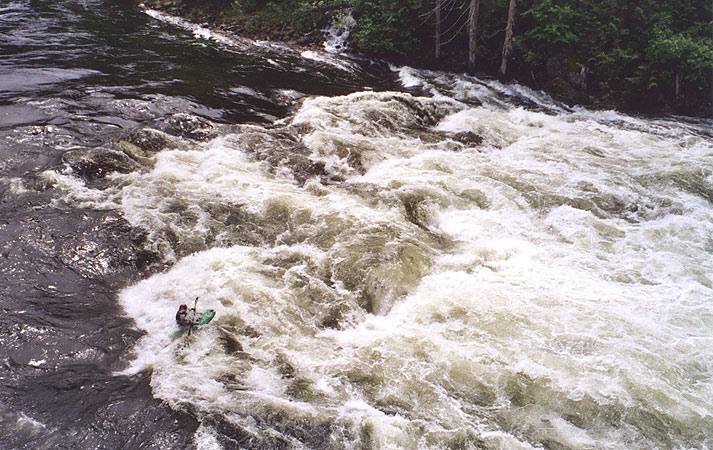
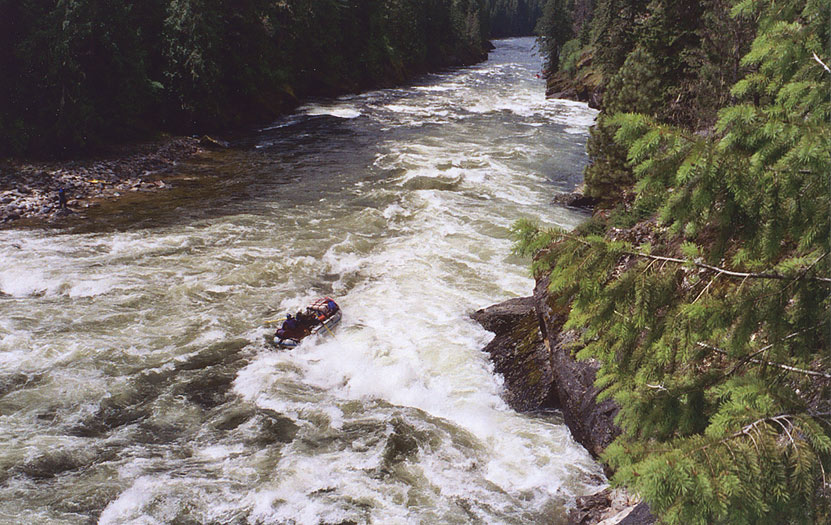
Downstream from Wolf Creek rapid the river widened and mellowed pretty dramatically for the final ten miles. There were still some great playspots along this section and a few class III rapids, but this was definitely the most mellow section on the whole trip.. In the photo below, note the class III that runs along the right side wall just downstream. This rapid was the closest we came to having the gear raft flip, because they got pushed over to the right and did a huge vertical stern-squirt move along the wall.. it was a pretty exciting ride for Scott and Jonathan!
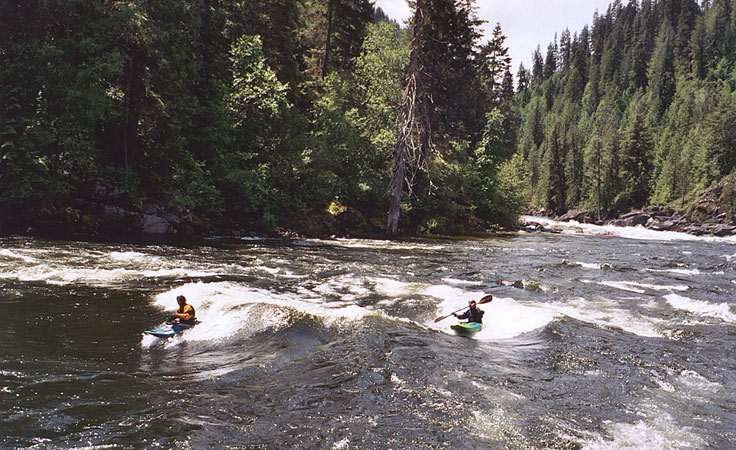

In the early afternoon of the sixth day we reached the takeout and unloaded the gear under sunny skies. It was a great finish to a superb paddling adventure!
This was definitely one of the best (if not THE best) multi-day river trips I have ever taken. We had a great crew that came together to cook, clean, set up and break down camp, and work together to ensure a safe trip for everyone. This kind of chemistry can be hard to come by, and I feel privileged to have met and paddled with such a fine group of paddlers. I look forward to future trips with 'The Tailfeather Gang'.. hopefully next year if everything works out..
Until next time,
Jason
Well, somewhere along the magic bus ride Chuck (who is a pretty hilarious guy) coined the phrase 'tailfeathered' in relation to getting worked in a hole, etc. So, of course, the rest of us picked up on it and for the rest of the trip it was non-stop: "Wow, you almost got tailfeathered in that hole." and "Sheesh, did you see me get tailfeathered on that eddy line?" and "Man, those eggs got tailfeathered pretty good.." and so on..
THE ORIGIN OF THE RAPID NAME 'HAM' ON THE SELWAY..
Hey, just read your great write up on the Selway and thought I'd share what I know about Ham rapid.
A few years back I was talking with a former girlfriend's father, who it turns out did a bunch of rafting in the fifties and sixties, including a trip (possibly one of the first) down the Selway. This was old school rafting in non self-bailing army pontoon rafts.
The gear raft flipped in the rapid now known as Ham and what followed was an epic yard sale of gear. Once the raft was recovered the rafters noticed their food cooler had opened in the flip and spilled its contents into the river. Fortunately, they noticed a canned ham floating in the eddy with them. That canned ham was their main source of food for the next several days, and thereafter they called the rapid "Ham."
Josh
We used L&B bussing service for the shuttle, which was an optimal solution, allowing us to leave all of our cars at the take out. It cost us $800 + $50 tip to do this, but considering that we avoided a 500 mile round trip shuttle I think this was money well spent, especially when you split the cost 9 ways.
We put on the river at 15,000 cfs on the Selway at Lowell gauge. This translated into or 4.5 feet on the Paradise gauge. The river peaked out at 18,000 cfs on the Selway at Lowell, or 5.5 feet on the Paradise foot gauge, about halfway through our trip (the time we were on the river is highlighted in blue, below). This was an epic flow for the gear boats, who didn't have a whole lot of sneak options. At this flow, the river was strong class IV for both kayaks and gearboats, though the kayakers had more sneak and portage choices. I think this was a great flow, allowing for optimal playboating opportunities and beefier rapids throughout.
The graph below shows the flows we were on the river at the Lowell Gauge, located at the mouth of the Selway. All foot-gauge references refer to the put-in gauge at Paradise.
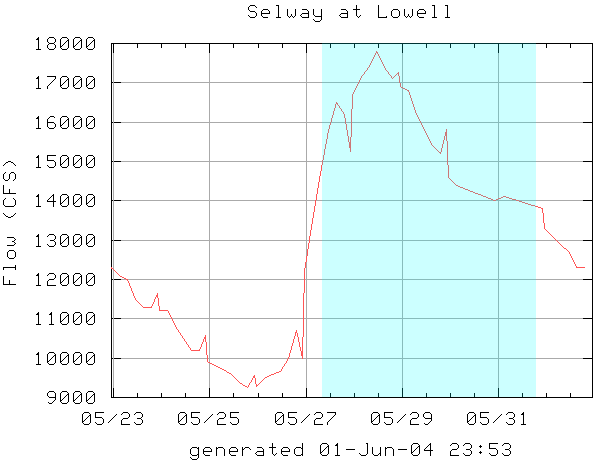
|
|